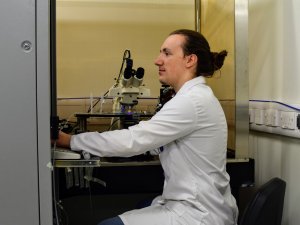Steven Houghton.
PhD Student. Funded by SoCoBio DTP and the Institute for Life Sciences
 I am interested in a second isoform of the GluN2A NMDA receptor subunit—called GluN2A-S—which is found in humans and non-human primates but not in rodents such as mice. GluN2A-S is a result of alternative splicing of the GRIN2A gene and results in a protein that has a shorter C-terminal domain and a unique sequence at the C-terminus. Lacking its binding motifs for PSD-95 raises the question of whether GluN2A-S localises to the synapse or whether it instead functions as part of the NMDA receptor at extrasynaptic regions. A better understanding of how GluN2A-S functions within an NMDA receptor will provide insight into synaptic communication at excitatory glutamatergic neurons. These neurons found in brain regions such as the hippocampus, and these receptors play key roles in learning and memory. Outside of the lab I enjoy cycling, weightlifting, and spending time with my family and friends.
I am interested in a second isoform of the GluN2A NMDA receptor subunit—called GluN2A-S—which is found in humans and non-human primates but not in rodents such as mice. GluN2A-S is a result of alternative splicing of the GRIN2A gene and results in a protein that has a shorter C-terminal domain and a unique sequence at the C-terminus. Lacking its binding motifs for PSD-95 raises the question of whether GluN2A-S localises to the synapse or whether it instead functions as part of the NMDA receptor at extrasynaptic regions. A better understanding of how GluN2A-S functions within an NMDA receptor will provide insight into synaptic communication at excitatory glutamatergic neurons. These neurons found in brain regions such as the hippocampus, and these receptors play key roles in learning and memory. Outside of the lab I enjoy cycling, weightlifting, and spending time with my family and friends.
Previous members:
Postdoctoral:
Dr. Ksenia Kurbatskaya
Funded by Rosetrees and Alzheimer’s Society.
Dr. Karla Salgado-Puga
Newton International Fellow.
PhD graduates:
Dr. Sarmi Sri. Thesis: “Emergence of synaptic and cognitive dysfunction in an inducible mouse model of Alzheimer’s disease”
Dr. Chrysia-Maria Pegasiou. Thesis: “Glutamate receptor composition in ageing human brain and in mouse models of synaptic degeneration”
Dr. Lauren McNicholas. Thesis. “The contribution of Src family kinases to synaptic function and plasticity in adult wild-type mice and an inducible mouse model of Alzheimer’s disease”
Dr. Hannah Warming. “Haemoglobin neurotoxicity, haptoglobin scavenging and synaptic function in subarachnoid haemorrhage.”
Alumni awards
Philippa Richardson. Awarded VHP Southampton Neuroscience Prize 2016 for “Outstanding performance in a Master research project”.
Natalie Wood. Awarded the John W Caddick Vacation Scholarship in Neuroscience 2014.
